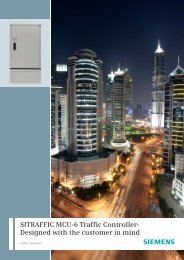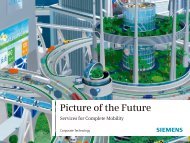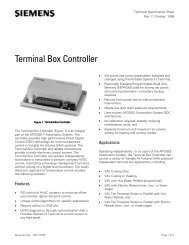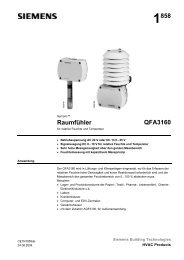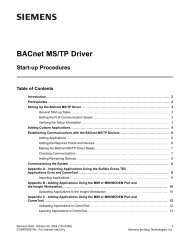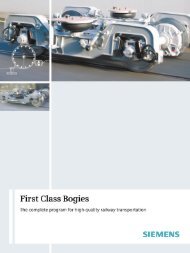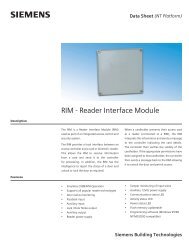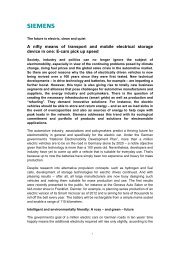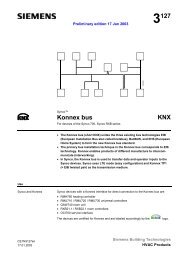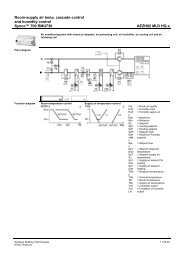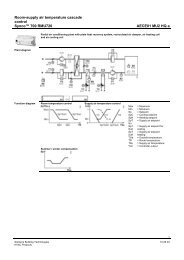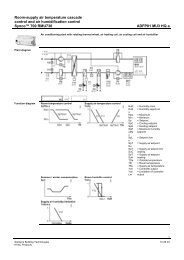UTC System Handbook - Siemens
UTC System Handbook - Siemens
UTC System Handbook - Siemens
You also want an ePaper? Increase the reach of your titles
YUMPU automatically turns print PDFs into web optimized ePapers that Google loves.
<strong>System</strong> <strong>Handbook</strong> for an STC <strong>UTC</strong> <strong>System</strong> 666/HE/16940/000<br />
In most cases, each controller, whether junction or pedestrian, is associated with<br />
one node. However, the <strong>System</strong> does allow more than one controller to be<br />
associated with a node. This is particularly useful when the controllers are close<br />
together.<br />
7.12 SCOOT Translation Plans<br />
SCOOT translation plans define the relationship between the SCOOT stages and<br />
fixed time stages for each controller on the node. These plans are prepared as part<br />
of <strong>System</strong> data preparation.<br />
Normally a 3 stage controller has three SCOOT stages with a one to one stage<br />
correspondence between <strong>UTC</strong> and SCOOT. The <strong>System</strong> allows for up to 2 (or 8 -<br />
see section 2.3) stages to be demand dependent in a similar manner to fixed time<br />
control. If a fixed period is required for a particular stage, such as a car park exit,<br />
then this stage may be combined with another stage to create one SCOOT stage.<br />
This "2 <strong>UTC</strong> stage" SCOOT stage then appears on-street as a fixed period <strong>UTC</strong><br />
stage plus a variable period <strong>UTC</strong> stage and the 4 <strong>UTC</strong> stage controller appears to<br />
SCOOT as having 3 stages. This approach does require careful calculation of the<br />
start and end delay for each associated SCOOT link.<br />
In some circumstances it is desirable to operate two or more controllers as one<br />
SCOOT node, typically where they are too close together to have loops on the<br />
internal links. The <strong>System</strong> achieves this by allowing a controller to be associated<br />
with a sub-set of the SCOOT stages and other controllers to be associated with the<br />
rest of the stages. In this manner all controllers referencing a SCOOT stage make<br />
the required moves at the same time. Using the fixed period mentioned above<br />
allows fixed offsets to be introduced between controllers in "multi-equipment"<br />
nodes.<br />
7.13 Plan Compliance Faults<br />
7.13.1 Introduction<br />
The Plan Compliance fault detection facility is designed to allow the operation of<br />
both intersection and pedestrian controllers to be monitored. Checks are made<br />
against the various controller timings stored in the <strong>System</strong> data and any departures<br />
reported as faults. The controllers are also monitored to check that they obey the<br />
control commands sent out by the <strong>System</strong>.<br />
Plan compliance checking is inhibited for 4 minutes after a new mode of control<br />
is requested at a site. This gives the controller time to respond to the new control<br />
algorithm (i.e. get in step).<br />
If a fault is detected the fault log is updated, a message sent to the <strong>System</strong> Log<br />
and the equipment isolated. The <strong>System</strong> has a command that allows this isolation<br />
to be inhibited. The <strong>System</strong> may be configured (S) such that, if isolation is<br />
inhibited, only the first occurrence of a plan compliance fault is reported or all<br />
xsuch occurrences are reported.<br />
666-HE-16940-000.doc Issue 31 Page 48




